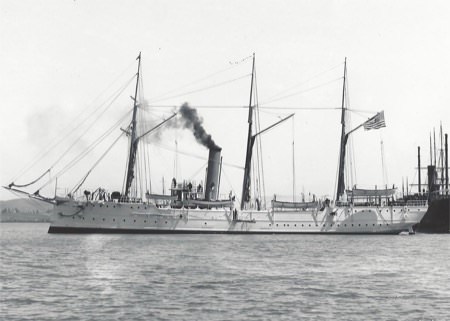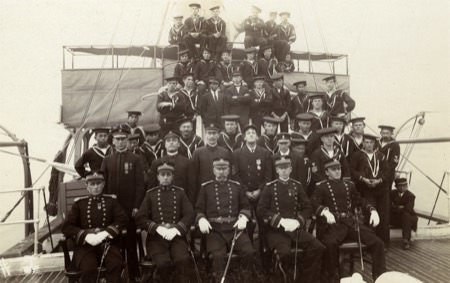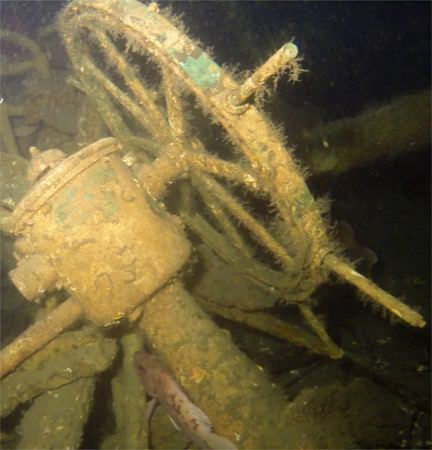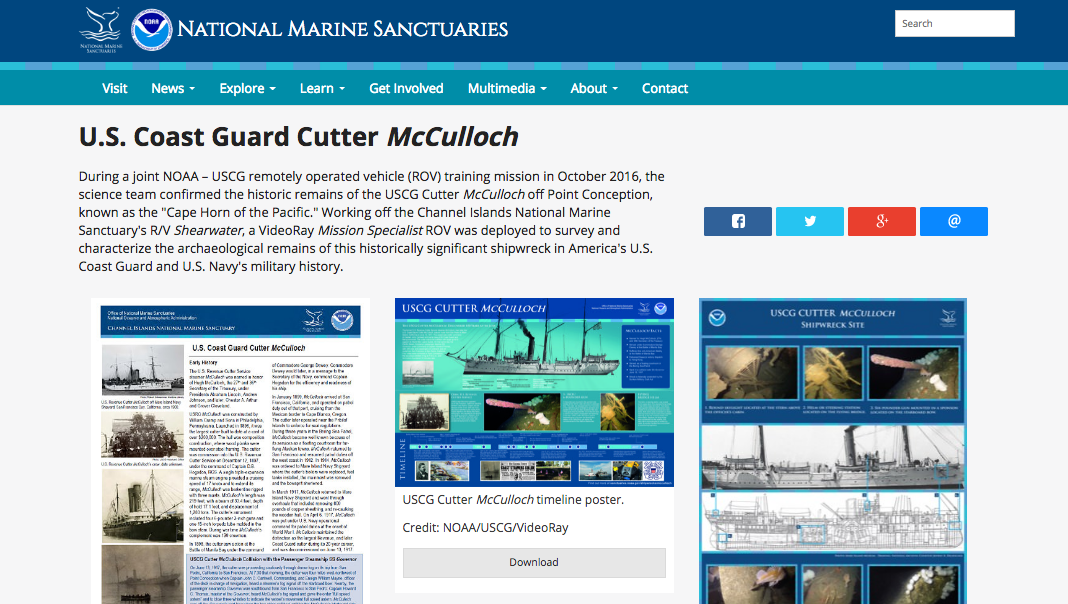Imagery available: U.S. Coast Guard, NOAA, National Park Service pay tribute to historic cutter that sank off Southern California 100 years ago
U.S. Coast Guard sent this bulletin at 06/13/2017 11:51 AM EDT
| News Release |
June 13, 2017 |
Imagery available: U.S. Coast Guard, NOAA, National Park Service pay tribute to historic cutter that sank off Southern California 100 years ago
 |
 |
 |
Editor's Note: Click on images to visit NOAA McCulloch website
SAN FRANCISCO — A century after a historic U.S. Coast Guard cutter was lost in a collision at sea off of Southern California, NOAA and the Coast Guard announced Tuesday the discovery of the vessel’s shipwreck remains.
The Coast Guard Cutter McCulloch, a ship that served with Commodore George Dewey in the Battle of Manila Bay in 1898, was discovered in October by a Coast Guard and NOAA research team in the Pacific Ocean off Point Conception in Southern California.
Officials from the two agencies and the San Francisco Maritime National Historical Park paid tribute to the cutter and its crews at the park’s Maritime Research Center at Fort Mason while announcing of the discovery of the shipwreck.
Commissioned in 1897 as a cruising cutter for the U.S. Treasury’s Revenue Cutter Service, a predecessor of the Coast Guard, McCulloch was part of the U.S. Asiatic Squadron that destroyed the Spanish Pacific fleet in the first major battle of the Spanish-American War.
In a message to the Secretary of the Navy, Dewey commended McCulloch’s commanding officer, Capt. Daniel B. Hogsdon, for the efficiency and readiness of his ship. After the battle, Dewey ordered the McCulloch to the nearest telegraph station in Hong Kong to deliver news of the victory to Washington and the world.
On June 13, 1917, the McCulloch sank off Point Conception following a collision in dense fog between the cutter and the passenger steamship SS Governor. McCulloch’s crew entire crew was rescued and taken aboard the Governor, but the ship’s acting water tender died days later from injuries he suffered in the collision.
“McCulloch and her crew were fine examples of the Coast Guard’s long-standing multi-mission success from a pivotal naval battle with Commodore Dewey, to safety patrols off the coast of California, to protecting fur seals in the Pribilof Islands in Alaska,” said Rear Admiral Todd Sokalzuk, the commander of the 11th Coast Guard District. “The men and women who crew our newest cutters are inspired by the exploits of great ships and courageous crews like the McCulloch. I extend the Coast Guard’s heartfelt thanks to our partners in the National Oceanic and Atmospheric Administration for helping us locate this important piece of our heritage and assisting us in preserving its legacy.”
At the time of its construction, McCulloch was the largest cutter built at a cost of nearly $200,000. The ship was equipped with a steam engine and three masts rigged with sails, giving it a cruising speed of 17 knots. The cutter’s armament included four 6-pounder 3-inch rapid firing guns and one 15-inch torpedo tube.
Following the Spanish-American War, McCulloch patrolled out of its homeport of San Francisco, cruising the Pacific Ocean from the Mexican border to Cape Blanco, Oregon. Built for Bering Sea patrols, the cutter deployed to enforce fur seal regulations in the Pribilof Islands off Alaska and served as a floating courthouse for far-flung Alaskan towns.
Last October, a joint NOAA and Coast Guard training mission confirmed the location of McCulloch’s remains. Working off the Channel Islands National Marine Sanctuary’s research vessel Shearwater, the multi-agency science team from NOAA, National Park Service, and Coast Guard Dive Lockers Alameda and San Diego, deployed a VideoRay remotely operated vehicle to survey and characterize the shipwreck. Coast Guard 11th District cutters Halibut and Blacktip provided vessel support.
 |
Click here to visit the NOAA McCulloch Website.
Cameras mounted on the ROV revealed McCulloch on the seabed lying on its port side. The vessel’s wooden hull planking and decks have succumbed to wood-boring organisms, leaving behind the steel skeletal remains of its frames. Marine growth, primarily Metridium anemones, drape the bow’s exterior while various species of marine life, including ling cod and vermillion and copper rockfish, inhabit the site.
During the ROV dives the team confirmed a number of diagnostic features consistent with historic photographs and ship’s plans of McCulloch published in 1914 including: the bronze 11-foot propeller; the steam engine and boilers; the engine room skylight; the anchor windlass and capstan; the 15-inch torpedo tube molded in the bow stem; the flying bridge and pilothouse helms; a number of deck skylights; a sounding machine; and three-pounder and six-pounder rapid firing guns arranged in sponsons mounted in the stern and the bow quarters of the ship.
“The identification of McCulloch is a result of our excellent collaboration with the Coast Guard, Bathymetric Research and other partners,” said Robert Schwemmer, the West Coast Regional Maritime Heritage Coordinator for NOAA’s Office of National Marine Sanctuaries and chief archeologist for the mission. “This discovery highlights an important chapter in U.S. Coast Guard and Navy history and gives us an opportunity to honor McCulloch’s chief engineer Frank Randall, the only American fatality at the Battle of Manila Bay, and acting water tender John Johansson who died from injuries sustained in the collision with the SS Governor.”
McCulloch rests on the ocean floor off of Point Conception near the 1917 collision site. Officials have not determined plans for the next phase of exploration of the shipwreck. McCulloch is not located within a NOAA Marine Sanctuary, but the ship is U.S. government property and is protected under the Sunken Military Craft Act of 2004. No portion of any government wreck may be disturbed or removed.
“We are honored to be part of this tribute to the McCulloch, and to the U.S. Coast Guard,” said Kevin Hendricks, superintendent at San Francisco Maritime National Historical Park. “America’s maritime heritage is rich and inspiring, and we must ensure that stories like this are passed down to future generations.”
-USCG-
The 11th Coast Guard District is headquartered in Alameda, Calif., and encompasses the states of California, Arizona, Nevada and Utah, the coastal and offshore waters out over a thousand miles including waters off of California and south to South America. Coast Guard operational units located throughout California carry out search and rescue, homeland security, law enforcement, marine safety and environmental protection, and aids to navigation missions in over 3.3 million square miles of ocean and inland waterways.
NOAA’s Office of National Marine Sanctuaries serves as trustee for a network of underwater parks encompassing more than 600,000 square miles of marine and Great Lakes waters. Through active research, management, and public engagement, national marine sanctuaries sustain healthy environments that are the foundation for thriving communities and stable economies.
San Francisco Maritime National Historic Park includes a magnificent fleet of historic ships, a Visitor Center, Maritime Museum, Maritime Research Center, and Aquatic Park Historic District. Located in the Fisherman's Wharf neighborhood, the park offers visitors the sights, sounds, smells and stories of Pacific Coast maritime history.

